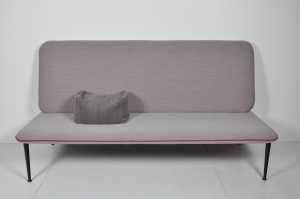Bertjan Pot
Nieuwleusen 1975
Bertjan Pot is more a modern-day inventor than a classic designer. His products stem from his fascination with particular materials and techniques. Impressed by the possibilities they offer, he playfully sets to work to discover their underlying codes. He seeks a logic in the production process that is so clear and intelligent that all other design criteria fall by the wayside. Pot believes that an optimum use of materials and technology distills an object to its essence and creates space for a poetic logic. When Pot reaches this moment in the design process, he knows that his product is a success.
Since 1999, he has consistently built his own colourful universe filled with contemporary innovations. Pot graduated from the Design Academy in Eindhoven in 1998 with his Knitted Lamp. Using a process he developed himself, he stretched knitted fibreglass saturated in epoxy resin over a balloon and allowed it to harden. He used the resulting objects, each of which had a unique form, to create a series of hanging lamps. Although these forms had a certain expressiveness and aesthetic, the fibreglass construction was not optimal. When the fibres are not flat, which occurs when they are knitted, the material does not behave optimally. He therefore decided to make a simpler lamp, using the leftover materials from his graduation project.
Pot now wound the epoxy-saturated fibreglass directly around the balloon to create the Random Light. The lamp attracted the attention of designer Marcel Wanders, who decided to produce it for the interior design label, Moooi, that he established in 2001. Moooi spent three years perfecting the design for manufacture and, following its commercial launch, the lamp became a great success. The idea of randomly wrapping a form in carbon fibre threads, resulting in a black linear copy of the object, proved to be an excellent technique for chairs. In 2003, Pot made the Random Chair by wrapping black carbon fibres over a polystyrene mould to create a super-light yet extremely strong construction. Pot then designed the Carbon Copy (2003) and Carbon Chair (2004) as variants of the famous dining chair by Charles & Ray Eames.
Although for Pot, the fusion of function and material is paramount, his work is not purely about function. He readily admits that he is not very good with practical things such as appliances with power cords, and is happier working with beautiful things. In 2005, as part of the Undercover Project organised by Stichting Sofa, a foundation that promotes contemporary decorative arts and furniture, and textile manufacturer De Ploeg, Pot was asked to come up with new ideas for upholstered furniture. His fantasy about seamless upholstery led to the idea of felting a chair in its entirety. The resulting Seamless Chair is simple yet sublime. Felting the wool makes the covering wear-resistant and conceals the construction. But the process is extremely labour intensive, and ultimately only two chairs were made: a green model, which is in the museum’s collection, and a red version. Simultaneously, Pot developed Slats, a parody of a classic garden bench designed as a light and confortable alternative to the heavy sofa. Each of the thirteen slats is individually upholstered, resulting in a visually light effect. The bench is manufactured by Drisag and is distributed flat-packed. An example is in the museum’s collection. Although Pot is free in his thinking, he is not a romantic designer. Unlike many designers of his generation, he is not interested in ‘narrative design’. For him, a single storyline is too limited: the magic resides precisely in the fact that his objects are open to endless interpretation.

Bertjan Pot
Nieuwleusen 1975

















